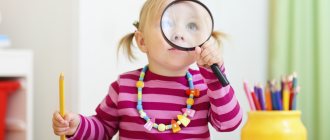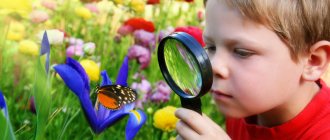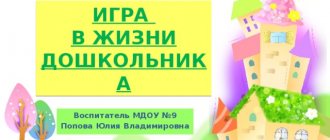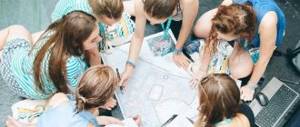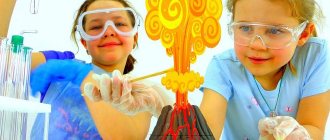Cognitive development - what is it in pedagogy
Cognitive development of preschoolers is a structure aimed at shaping the child’s personal experience. Through the learning process, the child can receive and then analyze all the information. Teachers wisely select the material, taking into account the age characteristics of the children, in order to simplify the process of understanding the lesson.
Methodology in pedagogy
Any child attending kindergarten strives to understand the world around him. Therefore, the cognitive process is aimed at meeting the needs of children in learning new things.
Note! Children's preschool age is a favorable time for forming an image of the world.
Before planning work with preschoolers, the teacher takes into account their age characteristics. This factor is a condition for the successful implementation of the lesson, as well as mastery of the material.
What is included in cognitive development
The content of preschool material assumes the following:
- development of interests;
- action cognition;
- an idea of the country, sociocultural values, traditions and other important events.
- presentation of features of nature.
The educational area may include the following:
- Introduction of elementary mathematical concepts.
- Development of research concepts.
- Familiarity with certain subjects.
Important! Cognitive development should involve the child himself solving problems that are significant to him.
Fundamentals of Cognitive Development
One of the most important tasks of teachers and educators is teaching children to navigate large information flows coming from different sources. Moreover, in addition to assimilation and structuring of information, the child must have the ability to search for the necessary data.
Cognitive development includes:
- formation of motivation for knowledge;
- organization of cognitive actions;
- development of creative imagination and activity;
- the formation of self-awareness;
- formation of initial ideas about oneself and other people.
Formation of cognitive development of preschool children in preschool educational institutions
By satisfying the natural need to understand the environment, the baby reveals different sides of his personality. A unique opportunity arises to demonstrate your talent in certain types of activities. From the age of 2, the child strives for independence, showing cognitive activity.
Formation of cognitive development of children in preschool age in preschool educational institutions
According to the state standard, a program specially compiled by teachers must ensure the development of the personality of future schoolchildren, taking into account their common interests. The transition to school age is associated with a change in the child’s leading activity. That is, games are replaced by educational activities. This period is associated with the development of mental functions. The child’s thinking changes, perception, attention, and memory are formed.
The formation of the cognitive development of preschool children in preschool educational institutions is aimed at developing curiosity, activity, and identifying talent. This structure forms primary ideas about objects in the surrounding world. The baby is given the opportunity to determine or analyze the features of objects (shape, color, size, material, rhythm, tempo, quantity, number, movement).
Important! The stages of cognitive development are a combination of curiosity, development of cognitive interest, and activity.
Relevance, goals and objectives
The relevance of the problem of improving the quality of preschool education at the present stage is confirmed by the state’s interest in the issues of education and development of children.
Goals and objectives of cognitive activity:
- curiosity;
- formation of consciousness;
- self-analysis on speech development;
- determination of primary ideas about the surrounding world.
Note! The main task of the teacher is to create motivation to search for information, to thirst for knowledge. Proper presentation of the material will ensure the child’s success at the next stage of education.
To achieve the goal, it is necessary to solve the following tasks:
- enrich the conditions that will contribute to the development of cognitive activity when raising preschool children;
- search, develop, and then implement new methods that ensure the effective formation of cognitive activity;
- increase the competence of parents on issues related to the development of the child’s cognitive activity.
Testing preschoolers for school readiness according to the Federal State Educational Standard
For example, you can consider the option with wood. Having planted the “seed”, what should you do to achieve maximum results? Naturally, take proper care of them. How should you look after them correctly? This is done very simply. It is necessary to create favorable conditions (sunny place, watering from a watering can).
General requirements
For children 2-3 years old, the objects of cognition are surrounding objects, sounds, and actions. Thanks to manipulation with them, incipient play activities, observations of people, animals, and natural phenomena, cognitive information is accumulated and assimilated.
Preschoolers aged 4 years are attracted not only by objects and actions, but also by their signs and properties (color, shape, size). And this contributes to their ability to conduct a comparative analysis by any category, combine objects into groups according to one characteristic, etc.
By the age of 5, preschoolers use speech as their main means of cognition. Children of this age easily perceive information, remember it well and can apply it in practice.
High-quality diagnostics allows you to make adjustments to the development of children
In a child of senior preschool age, the characteristics of cognitive development are the emerging skills of analyzing, drawing conclusions, generalizing, and classifying.
Based on these age characteristics of children, diagnostics are carried out. Games and tasks must be selected for younger children; older preschoolers need to be set up for work.
Evaluation criteria are being developed, they can be as follows:
- Low level - the child does not understand or does not complete tasks even with the help of an adult.
- Intermediate level - the child understands well what is required, completes tasks correctly and answers questions with a little help from an adult. Tries to independently explain his choice.
- High level - the child enjoys it, correctly completes the proposed tasks independently, and answers questions competently. Makes a simple analysis of his actions and explains his answer.
Diagnostic tasks and assessment results
It is necessary to talk with the child in a calm, confidential tone, praise for successes, and encourage him if something does not work out. The diagnostic results will show the level of cognitive development of children, and the adult will see which issues cause difficulties and require additional attention.
Types of activities for cognitive development in kindergartens
The main types of activities of children in preschool educational institutions include the following:
- Motor – enriches the motor experience of children, forms in pupils the need for motor activity.
- Play - develops the child’s play activity, forms a positive attitude towards himself, and introduces him to basic generally accepted norms and rules of relationships.
- Productive (cognitive component) - develops productive activity, develops children's creativity, introduces the child to the fine arts.
- Communicative - develops all components of oral speech.
- Labor - fosters a value-based attitude towards one’s own activities.
- Cognitive and research - develops sensory culture, forms a holistic picture of the world, broadens the horizons of children.
- Musical and artistic - introduces to the art of music.
- Fiction (reading) - develops the child’s speech apparatus.
Activities
Games for the development of cognitive processes in preschoolers
Initially, the teacher chooses an activity, taking into account the characteristics of the children.
- What color is missing? (for children from 3 years old)
The main goal is color perception, visual memory and attention.
The teacher’s task: put about 10 colored pencils on the table. The child looks carefully and remembers all the shades. Then the teacher asks you to close your eyes and removes one color. The baby opens his eyes and guesses what color is missing.
- Tender paws (for children from 3 years old)
Note! The main task is to relieve tension and reduce aggressiveness.
The teacher suggests choosing objects of different textures. This could be a brush, a paint container, cotton wool, a strap, or a perfume bottle. All these items are laid out on the table. The child is asked to bare his arm up to the elbow. The adult explains that an “animal” will walk along your hand and touch you with its affectionate paws.
With your eyes closed, you need to guess which “animal” touched your hand - guess the object. Touches should be stroking and pleasant.
Diagnostic examination of children 2-3 years old
Since visual-figurative thinking predominates in children of this age, all tasks are supported by illustrative material.
Knowledge of objects in the immediate environment
"What do you mean where?". In front of the child are objects (4-5 pieces each), united by one lexical topic “Toys”, “Dishes”, “Furniture”, “Clothes”, “Shoes”. An adult points to each of them and asks: “What is this?”, or to find one from a number of objects, for example, “Show me a cup”, you can ask: “What is the fabric or glass skirt made of?”
Color name test
"Errands." Prepare a large and small hare, a nesting doll, a car, red and green cups, large and small cubes. Ask your child to list objects, determine their color and size, and complete tasks of this type:
- treat the big hare with tea from a green cup. What else can you drink from?
- Place the machine on a large cube. Where should the cars be put away after playing? Etc.
Knowledge of family members
The child looks at the story picture “My Family” and answers the questions:
- who is shown in the picture? Who do you live with?
- what does mom do? What's your mother's name? I what does your mom do at home?
- what is grandma doing? Etc.
At the end of the conversation, it is advisable to ask: “Do we need to take care of each other? How?"
Knowledge about objects and natural phenomena
" Living and nonliving." Before your child illustrates various objects, you need to divide the pictures into two groups: “living” and “non-living”. For example, an airplane and a bird; fish and boat, etc.;
Test for 3-year-old children: name the animal
“Who has whom?” In front of the child are figures of wild and domestic animals. An adult asks “What animals are in front of you? Where do the bear and fox live? Horse and dog? Then he asks them to find and name their baby and place it next to the adult animal. “Where is whose house?” For the game, it is advisable to make models or a collage of a yard with outbuildings and a forest. An adult shows the child pictures of wild and domestic animals and asks him to find their home: put wild animals next to the model of the forest, and domestic animals next to the yard. Then the child says who he placed where.
“Who gives the voice?” The presenter shows cards with pictures of animals and birds and asks them to say who gives their voice in what way, for example, a cow moos, a dog barks, a duck quacks, etc.
“Who moves how?” Figures of animals, birds, insects are selected in advance for the child, the adult names one of them, and the child finds it and says how it moves (a grasshopper jumps, a fish swims).
Test for children 2 years old
By analogy, tasks are carried out to identify other knowledge and skills, namely about:
- herbs and trees (3-4 species);
- poultry;
- wild birds (2-3 species);
- vegetables and fruits (5-6 types);
- some properties of sand and water;
- labor actions of adults and children;
Lesson on cognitive development in kindergarten in the context of the implementation of the Federal State Educational Standard
The Federal State Educational Standard for Educational Education focuses on the specific content of educational areas. In this way, certain types of activities are implemented. The federal state standard develops the intellectual qualities of future schoolchildren. Therefore, there is a basic condition for the implementation of this direction:
- definition of cognitive tasks;
- the use of experimentation in working with children;
- implementation of goals.
Lesson in the context of the implementation of the Federal State Educational Standard
An example of compiling a GCD outline with elements of cognitive activity
Of great interest to children are such forms of organization as travel activities: “Journey to the land of electrical appliances”, “Journey to visit...”, “Journey along the river of time”. During the trip, each preschooler undergoes tests, overcomes obstacles, and performs tasks on attention, memory, and thinking. The game form will help children determine the past, present and future.
Breathing exercises for children in preschool educational institutions
The choice of topics for traveling into the past of objects depends on the age and the ability to show one or another example. Pedagogy uses methodological manuals by Dybina O. V. “What happened before... Travel games”, Dybina O. V., Rakhmanova N. P. “The unknown is nearby: Experiences and experiments for preschoolers”, “What objects are made of: games - activities for preschoolers "
Note! Leisure activities help to increase cognitive interest, for example, entertaining leisure time “Whose Lost is My Find,” fun leisure time “New Mystery of Famous Objects,” fun leisure time “We are Magicians,” as well as other interesting games—competitions, KVNs.
Organization of independent activities for children
In the process of independent cognitive activity, children have the opportunity to self-realize and develop creative activity. The child’s ability to work in a group, interact with other children—to cooperate and compete—is formed.
The main methods for developing the desire for knowledge and exploration in preschoolers are:
- information and communication technologies;
- search and research work;
- project work;
- gaming technologies.
Features of conducting classes for children with mental retardation and visual impairment
The mental and intellectual knowledge of children under five years old helps in defining such important concepts as “sign”, “symbol”, “time”. Initially, the teacher introduces the child to the globe, map, and symbols. The child begins to create portraits of the months, symbols of groups, interesting layouts, climatic zones with different landscapes.
Features of conducting classes for children with mental retardation
The teacher prepares certification material, which may include serious topics, for example, “Time.” The child's psychology is being restructured. The senior class in kindergarten learns to record time using a clock, study the past using the example of dinosaurs, and recreate corners of the distant past using a model.
Design of a cognitive zone in a kindergarten
In the younger group, the children's area is designed taking into account safety rules. When performing active movements, babies lack coordination. They may fall or throw some nearby object. To learn about the world around them, children will be helped by playing with sand and clay. Kids can be taught to draw their favorite characters.
The middle class chooses role-playing classes. Children with developed imagination carry out various game plans. When decorating the space, they use interesting objects that help develop the plot of the game.
Important! The older group requires special attention. In this case, the design of the zone becomes more complicated. It is necessary to use various objects that children at this age can distinguish. The teacher always supplements the material with new items, for example, clothes.
How children's areas are designed
Forms of work on the development of cognitive activity
The main condition for working with preschoolers is to focus on their capabilities and develop activities aimed at studying the world and the surrounding space.
The teacher should structure classes in such a way that the child is interested in research, is independent in his knowledge and shows initiative.
The main forms aimed at cognitive development according to the Federal State Educational Standard in preschool educational institutions include:
· children’s personal involvement in research and various activities;
· use of various didactic tasks and games;
· the use of teaching techniques that help in developing in children such traits as imagination, curiosity and speech development, replenishment of vocabulary, formation of thinking and memory.
The cognitive development of preschoolers is unthinkable without activity. To prevent kids from being passive, unique games are used to support their activity.
